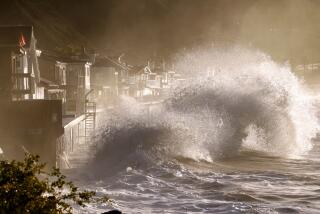Science / Medicine : El Nino Helps Create a Finch ‘Bird Boom’
- Share via
The exceptionally strong El Nino weather phenomenon in 1982 to 1983 that devastated human and marine life was a boon for terrestrial plants and birds on the Galapagos Islands, ecologists say.
Extreme climatic disturbances in the central Pacific Ocean caused by El Nino events may actually be a key to the success of some long-lived birds like two species of Darwin’s finches, the same birds that were a prime ingredient in Charles Darwin’s development of the theory of evolution a century ago, the scientists said.
The Pacific Ocean current known as El Nino sends hot equatorial waters sweeping up the North American coast, disrupting weather around the globe. Meteorologists believe that the change in the current is caused by failing trade winds that ordinarily are strong enough to push the hot equatorial waters of the Pacific Ocean westward.
El Nino, first named by South American fishermen, usually appears about Christmastime but was no gift in 1983 when it caused record floods that killed 2,000 people in Ecuador and droughts that parched Australia, the Philippines, Indonesia, Mexico, southern Africa and southern India, killing hundreds more.
The 1983 El Nino--the worst on record--came especially early, showing signs of starting in May, 1982. It affected the United States in the winter of 1982 and spring of 1983, when foul weather did at least $265-million damage, killed 14 people, and forced evacuation of 15,000 people in California.
But the destructive weather actually aided other life, including the finches of the Galapagos, Pacific islands on the Equator that belong to Ecuador.
Ecologists H. Lisle Gibbs and Peter R. Grant wrote recently in the journal Ecology that their long-term study of the ground finches on one small island of the Galapagos allowed them to gauge the startling effect of the heavy rains that came with the 1982-1983 El Nino.
The event brought total rainfall on Isla Daphne Major to levels that were 10 times higher than those recorded in any other wet season on the island.
“Most plant species responded by dramatically increasing seed production,” with some plants cranking out 10 times as many seeds as they usually do, the scientists said.
Two ground finch species on the island--the medium ground finch and the cactus finch--in turn responded to the increase in their food supply by breeding repeatedly. Whereas females usually lay one to five clutches of eggs, during the extraordinary year of El Nino they produced up to 10 clutches. More than three times the usual number of young survived to leave their nests.
The large number of young birds quadrupled the populations of the finch species on the islands, leading to an oddly structured age distribution not unlike a human “baby boom,” with more than 75% of the birds born in the one season.
El Nino events come every two to 11 years, the authors said, so for the birds, which may live for 12 years or more, “these once-in-a-lifetime events can have profound effects on important biological processes in these populations,” the ecologists wrote.





